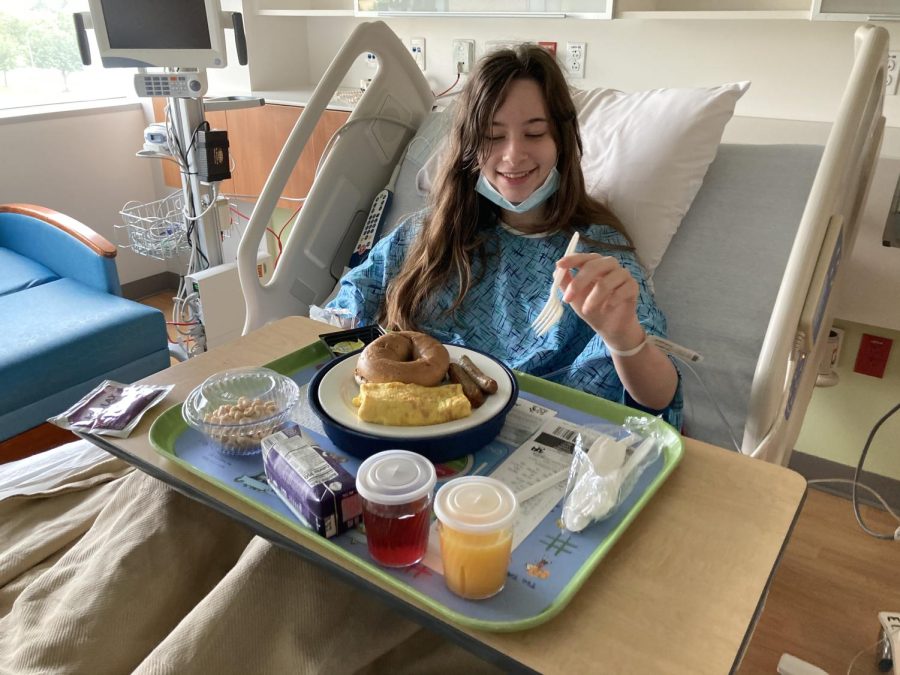Personal Column: Silent Killer
4 hours after being taken off DHE, and finally was allowed to have food in the morning.
A black 2-inch thick velcro strip strapped my right leg down, next to my left, and then an even larger one pressed me down on my abdomen. Immobile, I had wheeled out of the hospital wishing I could see my dad one last time before surgery. Maybe that’s cliché, but I had been with my mom this whole time. How many people actually survive surgery after their appendix ruptures?
In the ambulance, my mom sat next to me sobbing, which did not help at all. The repetitive blare of the sirens busted my eardrums as we moved off of the lot. Suddenly, nurses and doctors sprinted to stop the car. I had no idea what was going on. Suddenly my dad’s head popped up in the back door ambulance windows with blue and red lights flashing on his skin. Again, cliché, but this was almost like a movie.
When I finally met my driver, he greeted me with “Don’t worry,” smiling, “I’ve been rushed to a hospital while my appendix was rupturing, and I turned out great.” His assumption was wrong: my appendix was doing just fine.
Instead, I was diagnosed with Crohn’s, an incurable disease with no trace of contraction. Treated with monthly five-hour-long IV infusions administered with enough Benadryl to sedate a water buffalo. While these treatments temporarily alleviate my symptoms, they also disintegrate my immune system. Plenty of pain, but no scars to show for it.
Not that I need the scars but- well, you’ll see.
When I was too drowsy to finish a freshman year essay assignment, my English teacher once accused me of being lazy. I wanted to show her a photo of the IV bulging out my arm. I got back home from my infusion full of sedatives and turned in a half-assed assignment. I mean, I was only half awake. What more could I have done?
“Infusions? Are you sure you’re not just skipping class?” accused my substitute, “explain to everyone your phony lie to leave!” So I did, I told every stranger in that class about a disease I have that only close friends know about, then trudged out. She couldn’t physically see Crohn’s, so obviously, it couldn’t be real.
Even though my grades exceeded the requirement, the office personnel didn’t excuse any of the absences from my infusions, and I was denied the privilege that my classmates had of being excused from finals. Did they even know what an infusion center was?
Of course, an Algebra II final was scheduled right after I’d returned from an infusion, and I passed out in the middle of it. Still woozy, my eyes blurred as I tried to understand the rambling trigonometry question. I did not have the courage to ask my teacher for a retake after so many other adults refused to believe me.
As if Crohn’s wasn’t enough to deal with on its own, junior year, I was rushed to the emergency room three times in one week for migraines that literally knocked me out. I couldn’t even walk to the bathroom by myself. Yet the best advice the doctors gave me was, “Get used to it. This migraine could last a couple of years.”
So, I got used to it, and after missing two weeks of school, I started catching up on my assignments. That was great and all, but the next morning my migraine worsened, my eyes bulged and dilated, and even a dim computer screen blinded me. Every time I moved my head, it felt like lava was melting my brain. Once again, I wasn’t turning blue and my toes weren’t falling off, so I had nothing physical to prove my pain to anyone.
Three days later, I underwent a nerve ablation procedure to disconnect the pain receptors in the base of my head. Even though the surgeons had two excruciatingly painful needles in my skull, I couldn’t be put under anesthesia because of the risk of them severing the wrong receptor and causing irreversible brain damage. So I sat in a regular old chair and tried not to pass out from the pain.
I failed. The procedure failed too. I passed out and visibly turned blue. I guess making the pain more visible was not worth it.
A program on my computer translated my assignments audibly so I wouldn’t pass out from the strain. AP testing, however, was another story. I couldn’t use the program. I took all five with a migraine that squashed words together into thin lines that wiggled, waved, and swirled as if I were drugged.
I passed out after every single test. I also managed to pass every single test.
I went back to the hospital for an IV therapy called Dihydroergotamine(DHE). It’s considered a “can’t fail” treatment for migraines.
Inevitably it failed 26 hours in. My veins burned and collapsed. The nurse was yet another professional who showed little sympathy because there was no physical manifestation of my pain. “Would you rather the pain in your head or your arm?” she hissed at me. I was then referred to a therapist because “it must be mental.” Three months later I was finally diagnosed with dysautonomia. Simply put, blood pools in my feet and deprives my brain of blood, causing debilitating migraines. It’s easily treated with four microscopic blue pills.
If Crohn’s or dysautonomia caused me to physically have a cast or a crutch I think acceptance would be more easily earned from others. But it’s not visible. No one can see it. Even though my battle is silent, my suffering is real.
Your donation will support the student journalists of Carnegie Vanguard High School. Your contribution will allow us to cover our annual website hosting costs and fund field trips, competition fees, and equipment. We appreciate your support!

Hi, I'm a senior. I am a feature story editor and i have the best dog in the world.








Anonymous • Feb 25, 2022 at 11:56 am
I hope you feel better soon. If you ever need someone to talk to I’m here – 8002738255
Caitlin Liman • Dec 15, 2021 at 8:34 am
Your vulnerability in sharing this intimate part of yourself is so bold and admirable. I hope no one else treats you like that nasty sub did, but thanks again for your honest-written column. :]
Nadia Talanker • Dec 9, 2021 at 2:33 pm
I love this article so much. My absolute favorite line was,, “She couldn’t physically see Crohn’s, so obviously, it couldn’t be real.” I love the word choice and the way you describe everything is such a good use of your own personal voice. Wonderful job!!
Roxell • Dec 9, 2021 at 2:11 pm
You did it again Julian. This is an important topic that not many people talk about, and it should be. Awesome story!
Jahrel Noble • Dec 9, 2021 at 1:59 pm
This is amazing Julian! I think this is a really important topic and not one that many people know about, so I am glad you are sharing your story to teach others!
Hilary Nguyen • Dec 9, 2021 at 1:59 pm
I really enjoyed reading this- you wrote in a way that basically allowed me to embody what you were going through and that was really powerful to me.
Jessica Lin • Dec 9, 2021 at 1:58 pm
Your story is so eye-opening, and you were able to convey insight into invisible diseases so well.
Nicki Birangi • Dec 9, 2021 at 1:41 pm
This was such a good representation of what it’s like dealing with various chronic pains! I loved the insistence on adults not caring or taking you seriously
Brooke Ferrell • Dec 9, 2021 at 1:41 pm
The imagery in this piece is so vivid, and your quotes are so powerful. I wish you hadn’t had to go through this, but it made an amazing piece!
Nour Chibani • Dec 9, 2021 at 1:33 pm
The descriptive language and the use of quotes made this piece very enjoyable.